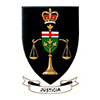Rules About Electronic Devices in Court
This Protocol applies to the public, self-represented litigants, counsel, paralegals, law students and the media. It outlines the permitted and prohibited uses of electronic devices in all court proceedings, whether in-person or virtual. This protocol does not apply to the following:
- Any electronic device that parties, counsel, paralegals, law students, witnesses, or members of the media or public require to participate in or observe a court proceeding.
- Court staff using an electronic device to produce a record of a proceeding.
- Persons who require electronic devices, or services requiring the use of electronic devices, to accommodate a disability.
Further, nothing in this policy affects a judge’s authority to determine what use can be made of an electronic device by anyone during an in person or virtual hearing.
Definitions
For the purposes of this policy:
- “Courtroom” means a room in which a proceeding takes place before a judge, whether wholly in-person, remotely, or where one or more participants attends the proceeding by video- or audio-conference.
- “Electronic device” means any device capable of recording and/or transmitting images, audio, or data, including but not limited to cameras, video recorders, cellular phones, smartphones, smartwatches, smart glasses, computers, laptops, and tablets.
- “Judge” means all judges and associate judges of the Superior Court of Justice, as well as all Deputy Judges of the Small Claims Court.
- “Proceeding” means a hearing before the Superior Court of Justice for the purposes of discussing or adjudicating a Court file.
- “Publicly accessible live communications” means the act of using an electronic device to transmit information from the physical courtroom or virtual courtroom to a publicly accessible medium (e.g. via X, live blogs or any other form of social media).
Prohibited Use of Electronic Devices
Talking on electronic devices is prohibited while court is in session.
Unless the presiding judge orders otherwise, members of the public observing an in person or virtual hearing are not permitted to use electronic devices in a courtroom. Electronic devices possessed by members of the public must be turned off and kept out of sight.
The public is not permitted to take photographs, video record or audio record at any time during a virtual court proceeding or inside a courtroom whether or not a proceeding is taking place. To do so may be an offence under s.136(4) of the Courts of Justice Act.
Litigants, counsel, paralegals, law students and media are not permitted to take photographs, video record or audio record at any time during a virtual court proceeding or inside a courtroom whether or not a proceeding is taking place unless the presiding judge has granted permission to do so, in accordance with s. 136 of the Courts of Justice Act.
No person shall photograph, video record or audio record at any time inside the courthouse, any person entering or leaving the room in which a court hearing is to be or has been convened, or of any person in the building in which a court hearing is to be or has been convened where there is reasonable ground for believing that the person is there for the purpose of attending or leaving the hearing as prohibited by s.136(1)(a)(ii) and (iii) of the Courts of Justice Act. No person shall photograph, video record or audio record at any other time inside the courthouse unless they have been authorized to do so by the Regional Senior Justice.
Permitted Use of Electronic Devices in the Courtroom
- Authorized Persons to use an electronic device in the courtroom
Unless the presiding judge orders otherwise, the following people may use an electronic device for the sole purpose of communication, provided the device is in silent mode and is used in a discreet and unobtrusive manner consistent with the remainder of this section:
-
- Counsel
- Paralegals who are licensed by the Law Society of Ontario
- Law students and law clerks assisting counsel during the proceeding
- Parties
- Media or journalists
- Requests to use an electronic device to audio record the court proceeding: approval & restrictions
Counsel, paralegals, self-represented litigants, law students, and media, must request the presiding judge’s approval to audio record the proceeding. The basis for the request must be for the sole purpose of note-taking. If permitted by the presiding judge, the following additional restrictions apply:
- The audio recording may only be taken when the proceeding is in session; and
- The electronic device cannot interfere with courtroom decorum or otherwise interfere with the proper administration of justice; and
- The electronic device cannot interfere with any court recording or other technology used in the courtroom; and
- The audio recording must not be transcribed, copied, shared, sold or transmitted in any fashion; and
- The electronic device cannot be used to send publicly accessible live communications where to do so would breach a restriction on publication made in the proceeding. Note: Anyone using an electronic device to engage in any such activity from the courtroom is responsible for identifying and complying with any publication bans, sealing orders or other restrictions imposed by legislation or by court order.
Enforcement
Anyone who uses an electronic device in a manner inconsistent with this section, or in violation of any order of the presiding judge, or in a way that the presiding judge determines is unacceptable, may be:
- Ordered to turn off the device.
- Ordered to leave the device outside the courtroom.
- Ordered to leave the in person or virtual courtroom.
- Ordered to remove any photographs, video images, or audio recordings posted online.
- Subject to prosecution for breach of 136 of the Courts of Justice Act.
- Subject to prosecution for any violation of a publication ban, sealing order, or other restriction on publication.
- Cited for Contempt of Court.
- Ordered to abide by any other order the presiding judge may issue.
